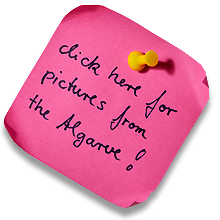- Location and arrival
- Quinta do Lago and the salt evaporation
- Lagoa dos Salgados
- Passadiços de Alvor
- The equipment
- Conclusion
- Download maps from the Algarve
The Algarve is a region located in the very south of Portugal. As the Algarve is very popular among tourists, this region can be reached by direct flights from many German airports. For example,
from Frankfurt, you can reach Faro Airport in about 3 hours.
Faro
is the capital of the Algarve and is situated right by the sea. As a recommendation for accommodation, I suggest the town of
Albufeira, as from there, the various locations are not far away. From Faro Airport, you can reach the town of Albufeira by car in about 40 minutes. Albufeira is a small town with around 20,000
inhabitants and offers plenty of accommodation options.

Based on my experiences, I can particularly recommend spring and winter as the best times to travel. Daytime temperatures range from 18 to 19 degrees Celsius in March and
between November to December. Even though there's no guarantee of sunshine during these seasons, there's a very high probability of having mostly clear or lightly clouded skies. These periods are also
favorable because many migratory birds visit the Algarve during this time. In March, when everything in Germany is still drearily brown and gray, vegetation in the Algarve is already starting to bloom.
(back to the top)
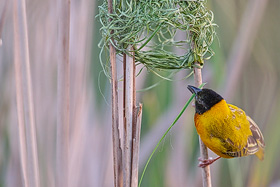
What does a golf course have to do with nature photography? This question is answered at the Quinta do Lago Golf Resort.(
see also map).
Quinta do Lago is located very close to the west of Faro Airport and is one of the most prominent golf courses in Europe. On the edge of the golf course, directly adjacent to the fairway, a large
artificial
pond
has been created.
Fortunately, one does not need a golf club membership to access the lake. However, when one sets their gaze on the upscale villas on the outskirts of the course, it quickly becomes clear that
a membership is not available at a bargain price. The artificial lake has a public access point on the seaside and also features an observation hut. Throughout the year, one can expect to encounter
various duck species, grebes,
western swamphens,
herons, and little bitterns at the pond. In the spring, there are good chances of observing black-headed weavers engaged in nest building.
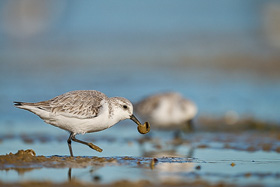
Right next to the lake on the golf course is the Ria Formosa Natural Park. This lagoon is directly connected to the Atlantic, and the tides cause a variety of animal
species to gather here, adapting to the different water levels. To the east, towards the airport and still easily accessible on foot, there are large
salt pans,
that are often visited by waders, spoonbills, herons, and flamingos. In 2023 the operator of the salt flats partially restricted access, so the freedom of movement is not as extensive as
it was in the years prior.
(back to the top)
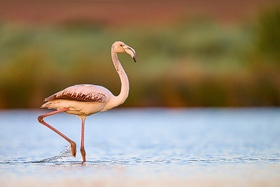
We are in the year 21 AD. The entire Algarve built up? No! A small lagoon continues to resist and defy the tourist concrete structures. A small enclave called Lagoa
dos Salgados is located right by the sea and is actually still completely undeveloped. Even though investors have been impatiently waiting for years to be able to build on this last small
piece of nature on the coast, fortunately, potential development has been prevented until today. The lagoon is situated about 10 km east of the coastal city of Albufeira and is easily
accessible via National Road M525 (
see map).
The lagoon provides an excellent habitat for flamingos, herons, spoonbills, harriers, waders, common snipe, ducks, grebes, songbirds, and many other birds.
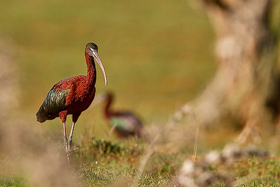
To the west of Lagoa dos Salgados, and thus in the immediate vicinity of the lagoon, there is a steppe-like
landscape
characterized by small trees and bushes. Due
to the sandy and low-lying terrain, there are good chances of encountering a
hoopoe.
In the area you can see also glossy ibis and the landscape is optimal for
little owls
.
Cattle egrets are also ubiquitous, particularly fond of staying near flocks
of sheep that are regularly driven freely through the area. The cattle egrets benefit from the sheep flocks, which stirs up small animals as it wanders about. Often and willingly, the
cattle egrets
sit on the backs of the sheep and let themselves be transported.
(back to the top)
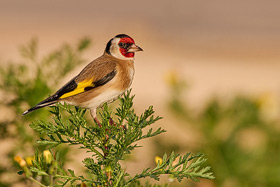
Approximately 40 km east of Albufeira is the small town of Alvor, which can be easily reached via the A22. Alvor is located on a lagoon and at the mouth
of the Rio de Alvor. The small hiking area
Passadiços de Alvor
is a popular winter habitat for songbirds and can be explored on foot, partly on constructed wooden boardwalks.
(
see map).
In terms of songbirds, especially in winter, you frequently encounter zitting cisticola, European stonechat, true sparrows, as well as bluethroats, sardinian warbler and also
hoopoes are often visible. In the water along the edges of the wooden boardwalks, spoonbills and little egrets are often spotted. Due to the presence of walkers, they have
somewhat overcome their fear of humans, making them somewhat easier to photograph than is usually the case.
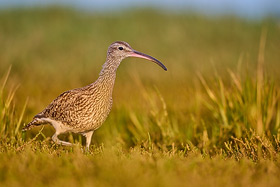
To the northwest, opposite the waterway 'Ribeira de Odiáxere,' you will find a good opportunity to photograph shorebirds on the beach. Since you
cannot directly cross to the other side from the Passadiços de Alvor area, the destination is reached by taking a large detour over National Road N125 (approximately 20 km).
Arriving at the beach, you encounter many shorebirds such as sanderlings, dunlins, ringed plovers, redshanks, ruddy turnstones, grey plover and many other beach birds. The
mix of sandy beach, rocks, and wetlands is also an ideal habitat for common redshanks, which are frequently seen there. The tides are clearly felt on the beach, so it is
helpful to check tidal predictions before a visit.
(back to the top)
For bird photography in the Algarve, focal lengths around 600mm are required. Even though there are occasional birds that are less shy, most birds are quite small, and
larger focal lengths are very helpful. A camouflage scarf is also useful in some situations. Additionally, a bean bag should be brought along, as around Lagoa dos Salgados,
you can also photograph birds from the car. Even though telephoto lenses are becoming lighter today, I would personally never forgo a tripod and therefore include it in
my travel luggage.
For me, the most beautiful times to visit the Algarve are spring and winter. The climate is pleasantly mild with daytime temperatures around 19 degrees Celsius, and the likelihood of
abundant sunshine is already high in the Algarve. Additionally, during these two seasons, there are plenty of migrating birds in the Algarve. In winter, many songbirds take advantage of
the mild temperatures in the Algarve for wintering, and in spring, the mating behavior is in full swing. Spring in Portugal, however, starts much earlier than in Germany, so vegetation
often blooms as early as March when we still experience cold winter weather in Germany.
Portugal is a very safe travel destination, the people are very hospitable, and the price level is pleasantly low, especially during the off-season.
(back to the top)
Here, you can download a map of the Algarve. To view and print it, you will need a PDF reader. I hope the map helps you to get a little orientation in the areas.
 map Portugal Algarve
map Portugal Algarve
written: May 2024, (author: Olaf Juergens)
updated: Juni 2025
 print version
print version








